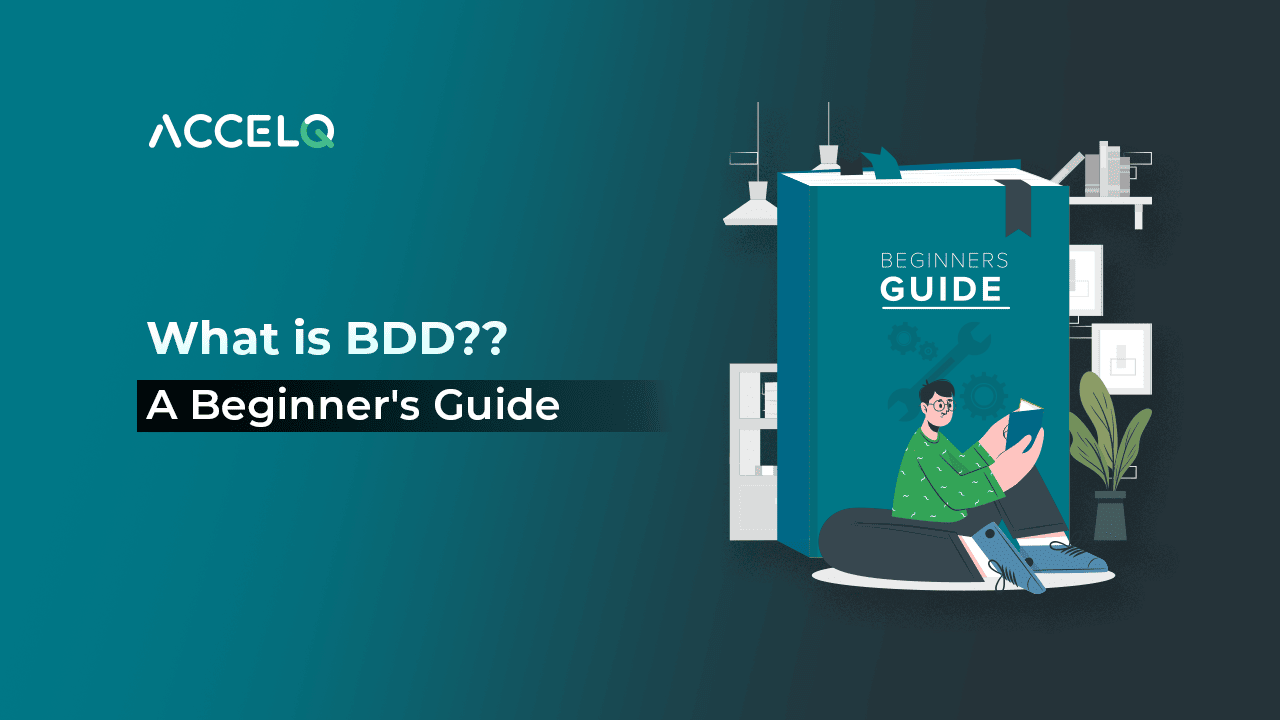What is Behavior-driven development (BDD) Testing? A Tester’s Guide

Organizations and teams need to understand each other more quickly when they are pointed in different directions, with budgets over their heads or deadlines that are too far out. But it could mean that we spend time building the software so users can finally get everything except for the one thing that initially seemed subtle. How do you remove confusion and assumptions when building out a diverse but skilled team?
Behavior-driven development testing (BDD) is a new agile software development methodology in which testers and testing teams write test cases in simple English. BDD can revolutionize the development process by shifting focus to collaboration and shared understanding among teams. It further allows the reform of requirements presentation and comprehension. BDD is beneficial because the complexity of coding will be compulsory in simple, understandable business languages for any layman.
This is the ultimate guide on BDD testing if you want to learn about it and how it works.
What is BDD Testing and the Gherkin Language?
BDD takes this even further by having standard language and test syntax. You can also declare how your features look in unit and acceptance tests. Make no mistake; you cannot be generous with your words; you must define tests. One of the advantages here is that you can write your specs and introduce tests as closely as possible to business needs.
They even have their own domain-specific language (Gherkin) for Behavior-driven development (BDD). This makes it so that the tests are comprehensible to all team members, not just technical teams. Here is the beauty of BDD testing — it offers a clear-cut format:
- Start with a Condition: Describe the starting scenario or ‘Given’ state.
- Describe the Action: Explain what happens next, or the ‘When’ part.
- Define the Outcome: Finally, specify what should result from the action, the ‘Then’ part. (Expected Result)
How BDD Testing Works?
BDD Testing is more effective in terms of collaboration and feedback. It is crucial for improved cooperation and clarity among various departments working on the software development project. BDD allows you to align a concept of what the system should do, operating within how a client might use it. So that developers and testers can have congruent perspectives and exactly the same understanding as business stakeholders.
BDD uses plain, non-technical language (such as Gherkin) to provide examples of how an application should behave. This decreases the opportunity for miscommunication and incomplete necessities, which in turn ensures we can achieve business desires and deliver software that is absolutely capable of addressing consumer needs.
Here’s a step-by-step guide on how to perform BDD testing effectively:
Step 1: Discovery Phase
- Collaborative Workshops: Conduct workshops involving developers, testers, and business stakeholders to discuss the requirements. Use these sessions to define the behaviors and expected outcomes.
- User Stories: Break down requirements into user stories. Each user story should focus on a specific functionality from the user’s perspective.
Step 2: Defining Scenarios
- Gherkin Syntax: Write scenarios using the Given-When-Then format. This format helps clearly define the context, action, and expected outcome.
- Given: Describes the initial context or state.
- When: Specifies the action or event that triggers the behavior.
- Then: It details the expected outcome or result.
BDD Example:
Scenario: User logs into the system
- Given the user is on the login page
- When the user enters valid credentials
- Then, the user should be redirected to the dashboard
Step 3: Automating Scenarios
- BDD Frameworks: To automate these scenarios, you can use BDD frameworks like Cucumber, SpecFlow, or JBehave. They provide a way to transform Gherkin syntax and everything in the GIVEN/WHEN/THEN into executable code steps.
- Step Definitions: Implement step definitions that link each step in the scenario to a piece of code. This code performs the actions described in the scenarios and verifies the outcomes.
Step 4: Writing the Code
- TDD Practices: Adhere to the Test-Driven Development (TDD), so minimal code is written only by making necessary test scenarios pass. Code refactoring is needed to ensure better quality and maintainability.
Step 5: Running the Tests
- Continuous Integration (CI): Integrate BDD tests into your CI pipeline to run them automatically on each code commit. This ensures immediate feedback on the impact of code changes.
- Monitoring Results: Regularly monitor test results to identify and address any failures promptly.
Step 6: Refinement and Feedback
- Iterative Process: Continuously refine scenarios based on feedback from testing and real-world usage. Update scenarios as new requirements emerge or existing ones change.
- Collaboration: Keep everyone in the loop so everyone knows what needs to be done.
Best Practices for BDD Testing
BDD improves early testing, which means teams find defects and misunderstandings of requirements much earlier in the development cycle. This results in quicker, less expensive resolutions. Moreover, BDD contributes to better test coverage, whether they are shared use cases or edge, and it ensures that the software has tested very well from a behavioral perspective. The tests serve as living documentation of the system, so this reference is always correct. Only the total of early detection, testing more extensively, and a user-centric approach create software that better fulfills its technical and business ambition.
Follow these best practices to get the most out of Behavior-Driven Development (BDD) testing:
Focus on User Behavior
Ensure that scenarios describe the application behavior from the user’s perspective. This user-centric approach helps create a product that meets actual user needs and expectations.
Keep Scenarios Simple and Atomic
Each scenario should test a single behavior or feature. It’s easier to understand, manage, and fix bugs in scenarios when they are simple.
Use Clear and Consistent Language
Write scenarios in plain, consistent language that all team members easily understand. Avoid technical jargon to ensure clarity and avoid misunderstandings.
Automate Scenarios
Using BDD tools such as Cucumber to run scenarios automatically. By automating scenarios, you can ensure they are executed consistently and can be integrated into your CI pipeline for instant feedback.
Regular Review and Refactor
Always review and improve scenarios to ensure they are still relevant and accurate. Refactor scenarios as needed to maintain their clarity and effectiveness.
Integrate with Continuous Integration (CI)
Add BDD tests to your CI pipeline to execute them immediately whenever you commit code. This interface lets you know right away how changes to the code affect things and helps maintain the code quality.
Benefits of BDD Testing
Behavior-driven development (BDD) testing offers the critical benefit of removing ambiguity through a sharper focus on requirements. This leads to a lack of agreement between how the requirements are going through and what has been implemented in code (as we know from traditional testing methodologies).
One more substantial plus in BDD is continuous feedback loops and incremental development. BDD tests early, often so that features can be tweaked/refined as the software grows. This agile approach to development combines with its iterative nature that elevates the speed of development and flexibility, granting teams the ability to adjust their work scope quickly or in new requirements.
Behavior-driven Development (BDD) offers several advantages, including enhanced software development and improved final product quality.
Improved Communication
BDD fosters better communication between developers, testers, and business stakeholders. By using a common language and collaborative approach, it ensures everyone has a clear understanding of the requirements and expected outcomes.
Early Detection of Defects
BDD encourages writing test scenarios before the actual development begins. This practice helps identify potential issues early in the development cycle, reducing the cost and effort required to fix defects later.
Clear Documentation
The scenarios written in Gherkin serve as both test cases and documentation. They provide a clear and concise description of the application’s behavior, making it easier for new team members to understand the system and for stakeholders to verify requirements.
User-Centric Development
BDD focuses on the application’s behavior from the user’s perspective. This ensures that the developed features align closely with user needs and expectations, resulting in a more user-friendly product.
Enhanced Test Coverage
By defining scenarios that cover various aspects of the application’s behavior, BDD helps ensure comprehensive test coverage. This reduces the chances of missing critical test cases and improves the overall quality of the software.
Facilitates Continuous Integration
BDD scenarios can be easily integrated into continuous integration (CI) pipelines. Automated tests run with each code commit, providing immediate feedback and ensuring that new changes do not introduce regressions.
Encourages Refactoring
With BDD, the focus is on writing clean and maintainable code. The scenarios act as a safety net, allowing developers to refactor code confidently, knowing that the tests will catch any deviations from expected behavior.
Alignment with Agile Practices
Behavior-driven Development Agile methodologies promote iterative development, continuous feedback, and close collaboration among team members. They help teams deliver high-quality software incrementally and adapt to changing requirements effectively.
Challenges of BDD
While there are many benefits to Behavior-Driven Development (BDD), it also faces challenges that teams must overcome in order to take full advantage of its potential. One significant hurdle to BDD adoption is the learning curve. Using Gherkin allows the behavior of application code to be written out as a standard format, while the test is another thing that requires how to write good scenarios and tests based on examples, which some teams still struggle with because they may not have experience working in terms of BDD.
Another challenge is introducing BDD testing in the development process, which will take significant time. Writing elaborate test scenarios based on user behavior that are in sync with business needs and conducting tests can be daunting. The upfront effort needed for BDD could be considered a bottleneck in fast development cycles like those of agile environments.
Here are some common challenges associated with BDD testing and potential solutions to address them:
Steep Learning Curve
Provide comprehensive training and resources to team members. Organize workshops and pair programming sessions to help everyone get accustomed to BDD practices and tools. Encourage collaboration between experienced and novice team members to foster knowledge sharing.
Time-Consuming Initial Setup
While the initial setup of BDD frameworks and the writing of scenarios can be time-consuming, the effort pays off in the long run. Start small by implementing BDD in one project or module and gradually expand its use. This approach allows the team to adapt without overwhelming them.
Maintaining Scenarios
Review and update scenarios regularly to ensure they remain relevant and accurate. Assign dedicated roles or responsibilities for maintaining scenarios and documentation. Automated tools can also help keep track of changes and ensure that scenarios are up to date.
Overhead of Writing Detailed Scenarios
Focus on writing scenarios that provide the most value. Prioritize critical and high-impact features for detailed scenarios while using simpler tests for less critical functionalities. This helps balance the effort and benefits of detailed scenario writing.
Ensuring Consistency Across Teams
Establish and enforce coding standards and guidelines for writing BDD scenarios. Use templates and examples to maintain consistency. Regular code reviews and collaborative sessions can also help ensure that all team members adhere to the established standards.
Resistance to Change
Promote BDD’s benefits to all team members and stakeholders. Highlight successful case studies and examples of BDD significantly improving project outcomes. Encourage an open-minded culture where team members are willing to embrace new methodologies.
Integration with Existing Processes
Rather than a complete overhaul, gradually integrate BDD into existing processes. Identify areas where BDD can complement current practices and start from there. Ensure that the integration process is smooth and enhances, rather than disrupts, the workflow.
Tooling and Technical Challenges
Choose the right BDD tools that fit your project requirements and team’s skill set. Invest time in setting up and configuring these tools correctly. Leverage community support and resources to overcome technical challenges and stay updated with best practices.
Conclusion
Behavior-Driven Development (BDD) empowers teams to deliver software that truly aligns with user expectations through enhanced collaboration and clear communication. By focusing on user behavior and utilizing tools like ACCELQ, teams can streamline their development process, catch defects early, and maintain high-quality standards.
ACCELQ’s codeless automation and seamless integration with BDD frameworks make it an invaluable asset for any team looking to implement BDD effectively. Ready to transform your development process and achieve better alignment with business goals? Explore how ACCELQ can revolutionize your BDD approach and start your free trial today!
Geosley Andrades
Director, Product Evangelist at ACCELQ
Geosley is a Test Automation Evangelist and Community builder at ACCELQ. Being passionate about continuous learning, Geosley helps ACCELQ with innovative solutions to transform test automation to be simpler, more reliable, and sustainable for the real world.
Discover More
 ACCELQ Vs Cypress. Why should you make the shift to ACCELQ?
ACCELQ Vs Cypress. Why should you make the shift to ACCELQ?
ACCELQ Vs Cypress. Why should you make the shift to ACCELQ?
 Cucumber Testing vs. ACCELQ – Which is the Best Tool for Agile Development
Cucumber Testing vs. ACCELQ – Which is the Best Tool for Agile Development
































